Supervision Column Observing Your Supervisee’s Work Directly: Video Deliberate Practice “Working with video will enhance your supervision practice and permit you to have greater confidence when attesting to your supervisees’ competence.”
By Jeff Chang, Ph.D., R. Psych
I
magine you play a sport called Thero. Your particular style is TheroNarrativo. Your neighbour also plays, using the Thero-Emoto style. Although you and your neighbour frequently discuss your Thero matches, you’ve never actually seen them play Thero, and they’ve never watched you play either. You realize that in all your Thero training, you hardly ever saw any senior Thero-ists playing. Your first Thero coach never let you watch their matches and hardly ever watched you play a full match. Occasionally they asked you to bring a highlight reel to your coaching sessions. Generally, they just took your description of your matches at face value. At master classes with world-renowned Thero stars, they discuss their philosophy of Thero, show highlight reels, and sell their books. However, they seldom show an entire Thero match. Now some novice Thero-ists have asked you for coaching. You are excited and flattered, but uneasy. As far as you can tell, you are a pretty good Thero player (you seem to win more than you lose), but the responsibility to mentor new players weighs on you. How can you help your proteges become excellent players without seeing what they are doing? With acknowledgement to Dr. Rod Goodyear for the metaphor, I’m referring, of course, to therapy and clinical supervision. We would think it
absurd to think that one could become a professional athlete, musician, or dancer without frequent observation and feedback of live practice. Yet clinical training and supervision seems to rely predominantly on verbal report. Deliberate practice is the focus of this column and the next. I start by making the case for a key requirement of deliberate practice—video recording. It is impossible to focus on specific skills without seeing actual performance. As Rousmaniere (2016) states, “[Discussing] a clinical case via notes or memory is like getting an art review by verbally describing your art instead of letting someone see it.” In the 1990s I was lucky to work somewhere with one-way mirrors and video recording equipment. More importantly, my employer promoted a culture of collaboration and transparency. The agency supported us to have regular team screenings and to record sessions. At another organization, trainees were required to observe five sessions by senior therapists before seeing clients of their own. We should model transparency to our supervisees. I urge you to require your supervisees to record sessions and to coach them to be confident when asking their clients for consent. Practicum students are typically required to show video. This may recapitulate the awkwardness of being a high school student
asking their neighbour a favor for a school assignment. However, students and Provisionals are not asking clients for a favor when they seek consent to record. Recording enables quality assurance, client protection, and skill development. Support your supervisees to say, “I’m still learning, so I record sessions as often as I can. Also, it allows my supervisor and me to provide you the best care possible.” With this direct unapologetic approach, most clients readily agree. Clients are seldom anxious about video when we aren’t as well . Access to technology is no longer an issue. In the 1980s I set up a tripod and a camera that had the profile of a small briefcase. By the 2000s, my wallmounted camera was about the size of a trumpet. These days, our phones, tablets, computers are unobtrusive and convenient, and telehealth platforms can easily record sessions. Working with video will enhance your supervision practice and permit you to have greater confidence when attesting to your supervisees’ competence. In the next column, I will describe how you can use video recordings to facilitate deliberate practice. Reference available upon request.
www.paa-ab.ca 13






